The back cover of a book is the outer surface on the opposite side of the front cover. Its primary function is to provide a brief summary of the book, author information, endorsements and other relevant details to attract potential readers and give them a glimpse of the content before they decide to purchase or read the book.
But it is not just about including these elements; it is about creating an informative and engaging back cover that stands out. In this blog post, we’ll explore the components of a back cover with examples from bestselling fiction and non-fiction books, design and accessibility considerations, free back cover templates, and the role of editing services.
So whether you are an author looking to design your back cover or a reader interested in understanding the elements of a back cover, read on to learn all you need to know.
What does a book back cover consist of?
The back cover usually consists of the following elements:
They may not necessarily all appear on the back cover. For instance, the cover may not include the author’s bio if they are famous because readers may already be familiar with their name, publications and achievements. Later in this article, you can see back cover templates, which illustrate this point.
Now, let’s delve into the elements of the book back cover in more detail.
Tagline
A tagline on the back cover is a catchy and memorable phrase that encapsulates the book’s essence. It often reinforces the main theme or draws attention to a key aspect.
To write a compelling book back cover tagline:
- Capture essence: Distil your book’s core theme or message into a few words.
- Invoke curiosity: Create intrigue by posing a question, using wordplay or hinting at a mystery.
- Be concise: Keep it extremely brief, typically one to two sentences.
- Continue in the blurb: create a sense of mystery, urgency and engagement that will be further explored in the blurb.
| Book | Tagline |
| Come as You Are by Emily Nagoski | An essential exploration of women’s sexuality that will radically transform your sex life into one filled with confidence and joy |
| Humankind: A Hopeful History by Rutger Bregman | How would your life and view of the world change if you knew people were good? |
| Atomic Habits by James Clear | Discover the secret to results that last. |
| Human Universe by Brian Cox and Andrew Cohen | Where are we? Are we alone? Who are we? Why are we here? What is our future? |
| Book | Tagline |
| The Boleyn Inheritance by Philippa Gregory | Three women, one prize: the crown of England. |
| Hunger Games by Suzanne Collins | Winning will make you famous. Losing means certain death. |
| Precious Thing by Colette McBeth | Best friends can make the deadliest enemies. |
| Percy Jackson and the Olympians: The Lightning Thief by Rick Riordan | Half boy. Half god. All hero. |
Blurb
A book blurb on the back cover is a concise and engaging summary of the book’s content. It is usually written to capture the reader’s interest and provide a sneak peek into the storyline.
To write an effective book back cover blurb:
- Hook the reader: Start with a compelling hook or question to capture immediate interest.
- Introduce the core: Briefly introduce the main character and the central conflict to establish the story’s core elements of the fiction book. For a non-fiction book, explain the main discoveries and arguments.
- Highlight importance: Convey what is at stake to create a sense of urgency. This may include what the protagonist stands to lose/experience or how the discoveries enclosed in the book can improve the reader’s life.
- Avoid spoilers: Provide enough information to generate curiosity without giving away crucial plot twists or spoilers.
- End with a call-to-action: Conclude with a call-to-action that encourages readers to delve into the book to uncover the full narrative or findings.
- Be brief: Aim for around 150 to 250 words.
- Create continuity: Develop further the sense of mystery started in the tagline.
An effective fiction book blurb example
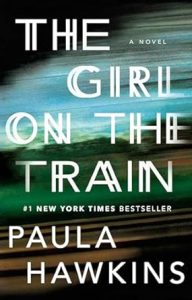
The Girl on the Train by Paula Hawkins
EVERY DAY THE SAME
Rachel takes the same commuter train every morning and night. Every day she rattles down the track, flashes past a stretch of cozy suburban homes, and stops at the signal that allows her to daily watch the same couple breakfasting on their deck. She’s even started to feel like she knows them. Jess and Jason, she calls them. Their life—as she sees it—is perfect. Not unlike the life she recently lost.
UNTIL TODAY
And then she sees something shocking. It’s only a minute until the train moves on, but it’s enough. Now everything’s changed. Unable to keep it to herself, Rachel goes to the police. But is she really as unreliable as they say? Soon she is deeply entangled not only in the investigation but in the lives of everyone involved. Has she done more harm than good?
This blurb is effective because it:
- creates an intriguing routine
- introduces key characters and their seemingly perfect lives
- promises a significant and shocking event (‘UNTIL TODAY’)
- raises questions about the protagonist’s reliability
- implies complications and consequences, building suspense and interest.
An effective non-fiction book blurb example
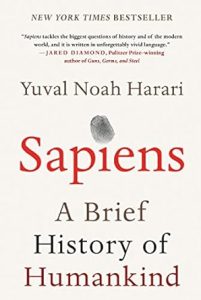
Sapiens: A Brief History of Humankind by Yuval Noah Harari
FIRE gave us power
FARMING made us hungry for more
MONEY gave us purpose
SCIENCE made us deadly
This is the thrilling account of our extraordinary history — from insignificant apes to rulers of the world.
This book blurb is effective because it:
- distils complex historical themes into four concise elements
- uses impactful words (FIRE, FARMING, MONEY, SCIENCE) to symbolise key developments
- creates a dynamic narrative flow of human history
- concludes with a bold statement.
Endorsements and reviews
Back covers often include endorsements from notable individuals or excerpts from reviews that highlight positive feedback about the book. Any awards or accolades received may also be mentioned.
Good reviews or endorsements on a book’s back cover should contain the following elements to be effective:
- Specific praise: Highlight specific aspects of the book that stood out, such as writing style, character development, plot twists or thematic depth.
- Relevance to target audience: Express how the book will resonate with the target audience, indicating the genre or themes that make it compelling for certain readers.
- Credibility of the reviewer: If the reviewer is well-known or has expertise in a relevant field, mention their credentials to enhance credibility.
- Brief and impactful: Keep the review concise, focusing on the most compelling points to capture attention quickly.
- Call to action: Encourage the readers to buy and read the book by creating a sense of urgency or importance.
Examples of impactful endorsements and reviews
‘You don’t know how much you need this book. It will change your life.’ — Melissa Hartwig Urban about Quit Like a Woman by Holly Whitaker
‘Interesting and provocative … It gives you a sense of perspective on how briefly we’ve been on this Earth.’ — Barack Obama about Sapiens: A Brief History of Humankind by Yuval Noah Harari
‘A fantasy like you’ve never read before.’ — #1NYT bestselling author Jennifer Armentrout about Iron Flame by Rebecca Yarros
‘Smart and sharp. Fast-paced and twisty.’ — Megan Miranda, author of The Only Survivors about First Lie Wins by Ashley Elston
Author bio
The author bio found on the back cover includes information about the author, including a brief biography, a photo, and details about other books they have written. This helps readers understand the author’s background and explore additional works. Moreover, it illustrates the author’s credibility and authority in the topic of the book.
Examples of effective author bios
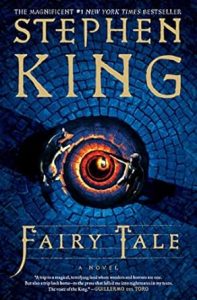
Fairy Tale by Stephen King
Stephen King is the author of more than sixty books, all of them worldwide bestsellers. His recent work includes Silly Summers, If It Bleeds, The Institute, The Outsider, and Sleeping Beauties (cowritten with his son Owen King). His novel 11/22/63 was named a top ten book of 2011 by the New York Times Book Review. He is the recipient of the 2018 PEN America Literary Service Award, the 2014 National Medal of Arts, and the 2003 National Book Foundation Medal for Distinguished Contribution to American Letters. He lives in Bangor, Maine, with his wife, novelist, Tabitha King.
This author bio is effective because it:
- highlights King’s extensive bibliography and success as a worldwide bestselling author, establishing credibility
- mentions recent publications, showcasing the author’s continued work and relevance
- includes prestigious awards and honours
- adds a personal touch by mentioning his residence and family, providing readers with a glimpse into the author’s life.
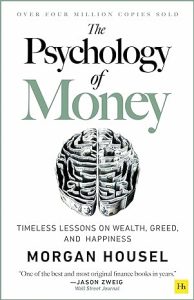
The Psychology of Money by Morgan Housel
Morgan Housel is a partner at The Collaborative Fund and a former columnist at The Motley Fool and The Wall Street Journal. He is a two-time winner of the Best in Business Award from the Society of American Business Editors and Writers, winner of the New York Times Sidney Award, and a two-time finalist for the Gerald Loeb Award for Distinguished Business and Financial Journalism.
This author bio is effective because it:
- showcases multiple awards, emphasising the Housel’s excellence in business and financial journalism
- established professional credibility by highlighting author’s background as a writer for reputable and relevant magazines.
ISBN, barcode and publisher’s details
Finally, the back cover contains the three important elements associated with retail. First, the International Standard Book Number (ISBN) uniquely identifies the book, which is helpful for bookstores, warehouses and libraries storing the book. Next, the barcode is scannable for retail purposes. Last, publisher details provide information about the entity responsible for publishing the book, including the name and logo of the publisher or press.
International Standard Book Number (ISBN)
ISBN is a unique thirteen-digit book identifier assigned to each edition of the book. In other words, an eBook, audiobook, hardcover and paperback edition of the same book will have different ISBNs.
How to obtain an ISBN?
Each country has a different ISBN issuer, but they are all overseen by the International ISBN Agency, which introduced ISBN in 1970. You can contact the ISBN provider from your country online. Some offer ISBNs for free, and others sell ISBNs in packs of one, ten, hundred, or a thousand. For instance, in the UK, USA and Australia, ISBN providers sell with prices decreasing the larger the package. On the other hand, in New Zealand, South Africa and Canada, self-publishing writers and publishers can obtain ISBNs for free.
| Country | ISBN provider | x1 | x10 | x100 | x1,000 |
| Australia | Thorpe-Bowker | A$44 | A$88 | A$480 | A$3,035 |
| Canada | ISBN Canada | C$0 | C$0 | C$0 | C$0 |
| New Zealand | National Library of New Zealand | NZ$0 | NZ$0 | NZ$0 | NZ$0 |
| South Africa | National Library of South Africa | R0 | R0 | R0 | R0 |
| UK | Nielsen ISBN Store | £91 | £174 | £379 | £979 |
| USA | Bowker | $125 | $295 | $575 | $1,500 |
Note that print-on-demand (POD) platforms like Amazon KDP, Ingram Sparks and Lulu provide their free versions of ISBNs but with a caveat. If you choose their identifiers instead of the officially recognised ISBNs often, they will limit where you can sell your book.
| POD platform | Identifier | Cost | Book sales |
| Amazon KDP | ASIN | free | only on Amazon KDP |
| IngramSparks | IngramSparks ISBN | free | only on IngramSpark and only in the USA |
| Lulu | Free Lulu ISBN | free | only on Lulu but if eligible for Global Distribution can be sold via participating retail channels |
Barcode
Like ISBN, a barcode is necessary for books that will be sold. Barcodes can be obtained for free. For instance, you can try the Online Barcode Generator to get a free barcode for your back cover. POD platforms like Amazon KDP, IngramSpark and Lulu also provide them for free with their cover templates.
How to design a back cover?
Here are some key considerations when designing a back cover of a book.
- Function over flair: Prioritise conveying essential information like the blurb, author details, and ISBN over excessive design elements. Avoid clutter, and leave ample white space for a clean and organised look.
- Look at other books in the same genre: Analyse successful books in your genre to understand design trends and audience expectations. This helps your book fit in while also standing out.
- Use style to tell a story: Align the back cover design with the book’s tone and content. The design should offer a glimpse into the narrative or themes, creating a cohesive visual experience.
- Match the front cover: Ensure consistency between the front and back covers. The design elements, colour scheme and typography should complement each other, presenting a unified visual identity.
- DIY vs hiring somebody: Consider your design skills and the complexity of your vision. If confident, DIY may be cost-effective. However, hiring a professional designer can ensure a polished and effective result. To DIY a book cover, try one of the automated tools, such as Canva’s Magic Studio, Midjourney AI, Adobe Firefly or Microsoft Design.
How to incorporate accessibility into a back cover design?
Accessibility in the context of book cover design refers to creating covers that are inclusive and can be easily understood, navigated, and appreciated by individuals with diverse abilities. This includes considerations for people with visual, cognitive, or motor impairments. Designing with accessibility in mind ensures that everyone, regardless of their abilities, can access and engage with the book cover content.
Key aspects of accessibility in book cover design may involve:
- Contrast and legibility: Ensure there is sufficient contrast between text and background colours to aid readability. High contrast is especially important for readers with visual impairments.
- Font size and style: Choose a clear and legible font with a size that is easily readable, even for those with visual impairments. For instance, Arial, Comic Sans, Verdana, Tahoma, Century Gothic, Trebuchet, Calibri and Open Sans typefaces are more accessible.
- Alternative text for images: If your back cover includes images, provide alternative text (alt text) for each image. Alt text is crucial for individuals using screen readers to understand the visual elements.
- Readability in various formats: Ensure that the back cover is readable in different formats, including print and digital. Digital versions should maintain readability when viewed on various devices and screen sizes.
- Consider readers with colour blindness: Be mindful of colour choices, as some readers may have colour vision deficiencies. Avoid relying solely on colour to convey important information. Also, avoid combining red and green and instead try blue and red (or orange and yellow combination). Finally, use highly contrasting colours and play with the dark/light saturation to make the contrast more pronounced.
- Readable layout: Organising information in a clear and logical manner, allowing easy navigation for individuals with cognitive or attention-related challenges.
How can editing services help elevate a back cover?
There are several benefits of using professional editing services when designing a book back cover. For instance, thorough proofreading can catch any typos, spelling errors or formatting issues, maintaining a polished and error-free appearance. Likewise, copyediting can help ensure consistency with the front cover, the book’s content and other books in the series. Here are some other examples of how editing services can help in a back cover design:
- Clarity and conciseness: Editors ensure the back cover text is clear, concise and effectively communicates the book’s essence, helping readers quickly understand the content.
- Grammar and language: Editing services correct grammar, syntax and language issues to present a polished and professional back cover, enhancing the overall impression of the book.
- Target audience appeal: Editors assess the language and tone to ensure it resonates with the target audience, maximising the back cover’s impact on potential readers.
- Consistency with content: Editors help align the back cover text with the book’s content, ensuring accuracy and coherence in presenting the narrative, genre or themes.
- Feedback on blurb effectiveness: Professionals can provide feedback on the effectiveness of the blurb, suggesting improvements to make it more engaging, intriguing and aligned with market expectations.
Back cover templates
Here are four free back cover templates for your inspiration.
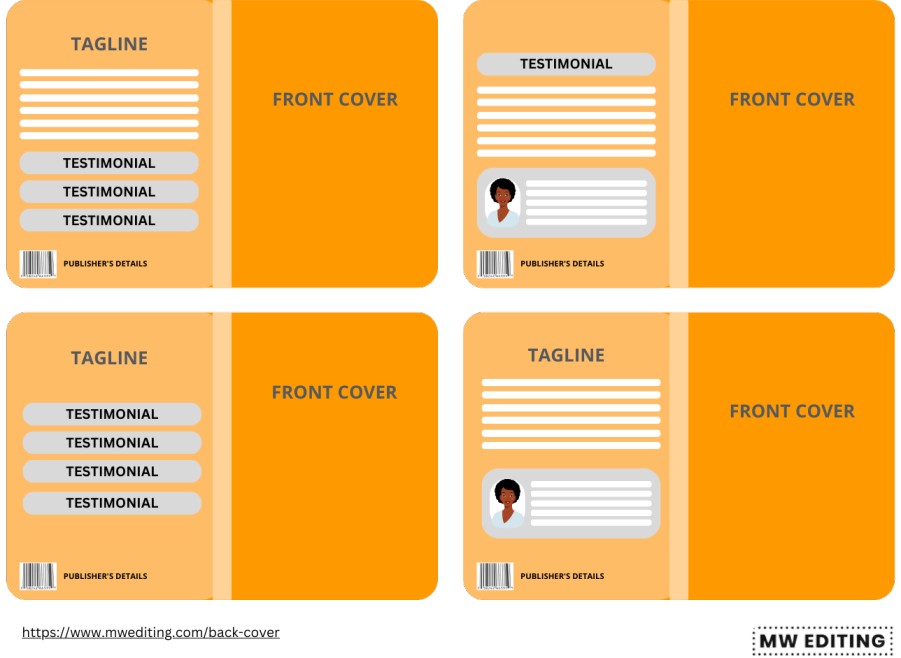
Final thoughts
In conclusion, creating an impactful back cover is essential to presenting a book to potential readers. This comprehensive guide has explored the crucial elements of an engaging back cover, ranging from taglines and blurbs to endorsements, author bios and technical details like ISBN and barcode. Remember, the back cover serves as a gateway to the world within the book, enticing readers with a glimpse of the content. By carefully considering design and accessibility and utilising editing services, authors can elevate their back covers to effectively connect with their target audience and make a lasting impression.
I am an experienced editor working with non-fiction, academic and business books. If you need a second pair of eyes, proofreading and editing the text selected for the back cover or preparing your manuscript for publication, contact me for a free sample edit (and remember to use my early bird discount).


